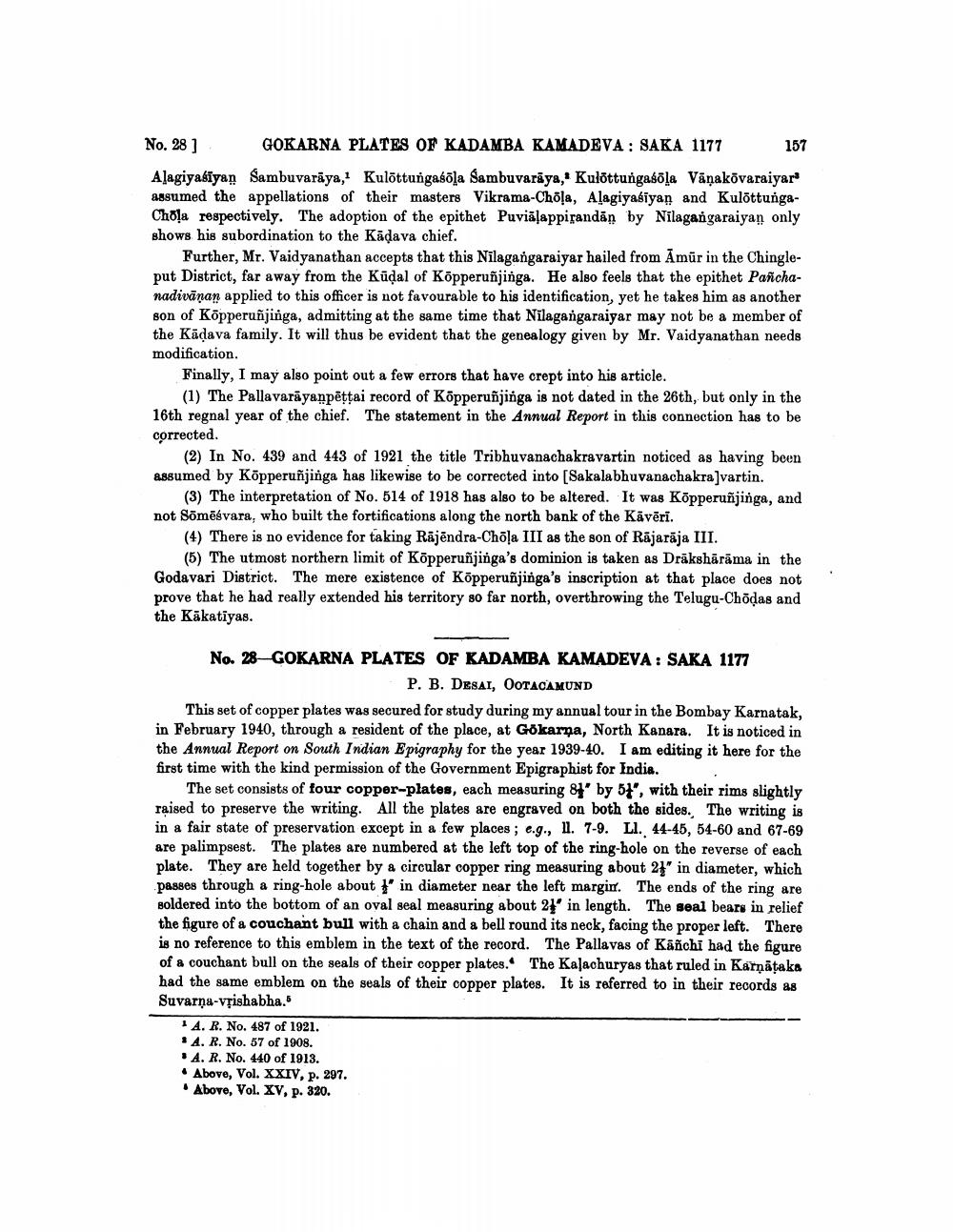________________
No. 28 GOKARNA PLATES OF KADAMBA KAMADEVA: SAKA 1177 157 Alagiyaliyan Sambuvaraya, Kulöttungasola Sambuvarāya," Kulottungasola Vāņakovaraiyar' assumed the appellations of their masters Vikrama-Chola, Alagiya iyan and KulõttungaChoļa respectively. The adoption of the epithet Puviālappirandān by Nilagangaraiyan only shows his subordination to the Kādava chief.
Further, Mr. Vaidyanathan accepts that this Nilagangaraiyar hailed from Āmūr in the Chingleput District, far away from the Kudal of KÕpperuñjinga. He also feels that the epithet Pafchanadivānan applied to this officer is not favourable to his identification, yet he takes him as another son of Kõpperuñjinga, admitting at the same time that Nilagangaraiyar may not be a member of the Kādava family. It will thus be evident that the genealogy given by Mr. Vaidyanathan needs modification.
Finally, I may also point out a few errors that have crept into his article.
(1) The Pallavarāyanpēţtai record of Kõpperuñjinga is not dated in the 26th, but only in the 16th regnal year of the chief. The statement in the Annual Report in this connection has to be corrected.
(2) In No. 439 and 443 of 1921 the title Tribhuvanachakravartin noticed as having been assumed by KÕpperuñjinga has likewise to be corrected into [Sakalabhuvanachakravartin.
(3) The interpretation of No. 514 of 1918 has also to be altered. It was Kõpperuñjinga, and not Sõmēsvara, who built the fortifications along the north bank of the Kävēri.
(4) There is no evidence for taking Rājēndra-Chõļa III as the son of Rājarāja III.
(5) The utmost northern limit of KÕpperuñjinga's dominion is taken as Drākshārāma in the Godavari District. The mere existence of KÕpperuñjinga's inscription at that place does not prove that he had really extended his territory so far north, overthrowing the Telugu-Chödas and the Kakatiyas.
No. 28-GOKARNA PLATES OF KADAMBA KAMADEVA: SAKA 1177
P. B. DESAI, OOTACAMUND This set of copper plates was secured for study during my annual tour in the Bombay Karnatak. in February 1940, through a resident of the place, at Gokarna, North Kanara. It is noticed in the Annual Report on South Indian Epigraphy for the year 1939-40. I am editing it here for the first time with the kind permission of the Government Epigraphist for India.
The set consists of four copper-plates, each measuring 81' by 5t', with their rims slightly raised to preserve the writing. All the plates are engraved on both the sides. The writing is in a fair state of preservation except in a few places; e.g., 11. 7-9. LI. 44-45, 54-60 and 67-69 are palimpsest. The plates are numbered at the left top of the ring-hole on the reverse of each plate. They are held together by a circular copper ring measuring about 21" in diameter, which passes through a ring-hole about ' in diameter near the left margirr. The ends of the ring are soldered into the bottom of an oval seal measuring about 21' in length. The seal bears in relief the figure of a couchant bull with a chain and a bell round its neck, facing the proper left. There is no reference to this emblem in the text of the record. The Pallavas of Kāñchi had the figure of a couchant bull on the seals of their copper plates. The Kalachuryas that ruled in Karnataka had the same emblem on the seals of their copper plates. It is referred to in their records as Suvarna-vȚishabha.5
A. R. No. 487 of 1921. * A. R. No. 57 of 1908.
A.R. No. 440 of 1913. • Above, Vol. XXIV, p. 297. . Above, Vol. XV, p. 320.




